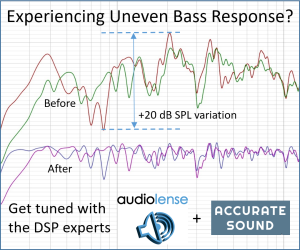I take advantage of the thread.
Regarding the reduction of crosstalk, Ubacch usage is increasing, but the results are poorly documented and in any case always of a subjective type.
And I suspect that any such system cannot provide particularly good results on a large listening area, it is technically impossible, therefore it is difficult to justify that cost.
The search for the best performance/compromise on a large listening area rather than on a sweet spot should be the focus for today DRC developments.
Dirac in fact is attempting at this with its Bass Control and Active Room Treatment (ART) technologies.
But having Dirac Bass Control in my system I can say that it is far from being in the state of the art... it manifests extreme sensitivity to measurements, to the point that two filters created with the same measuring scheme sound completely different.
Not only that, with the same measurements the software is able to generate at least two different types of filters, based only on the filter creation iteration (if I press create one filter is generated... and then if I press again a little different filter is created... and so on... inexplicable).
In addition, the filters generated with Bass Control dramatically increase the group delay at low frequencies, even going from 20ms of the raw system to 120ms of the corrected system.
Dirac admits this malfunction but is in hiding in finding a solution.
As for ART, it seems more promising but the result depends a lot on how many speakers the system has and how much they extend at the bottom.
For the classic 2.x stereo there is to be seen what benefits it will provide.
So going back to Audiolense, I believe and I take the liberty of suggesting an algorithm to improve the bass on a wider area as the next step of development. Basically the low frequencies is where there is the most variation depending on the position in the room, and from the research they account for a good 30% / 40% in the perceived audio quality.
Improving the phase coherence between the two speakers could be a subsequent or parallel development step (as Acourate DRC does).
Reducing crosstalk seems much less a priority than these things, and surely could not justify the development effort compared to the potential consumer growth.
Just my 2 cents...













